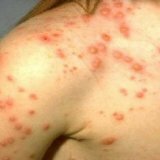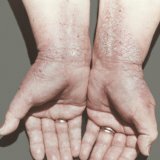Hyperkeratosis of the feet: treatment with ointments and folk remedies
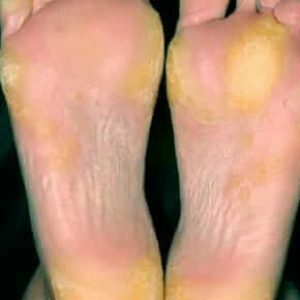
Hyperkeratosis of the feet is a pathological condition characterized by excessive thickening and keratinization of the epidermal layer of the skin of the plantar area.Skin becomes dry and rough.They appear large corns and painful bleeding cracks. Diagnosis and treatment of pathology is carried out by a dermatologist or specialist-forgery;In many cases, consultation with an orthopedic doctor is required. Complex therapy of hyperkeratosis includes hardware pedicure, application of special local preparations, peeling and foot baths.
Contents: How and why does hyperkeratosis develop?How to treat hyperkeratosis of the feet?How and why does hyperkeratosis develop?
In case of pathological growth the stratum corneum of the epidermis can reach a thickness of 2-3 mm to 1 cm and even more.The affected zones on the plantar area, in the projection of the metatarsal and phalangeal joints and in the interdigital spaces usually have the form of narrow bands or resemble rice kernels.
External causes:
- increased pressure on the feet against a background of excess weight;
- incorrectly matched shoes( size mismatch or inconvenient model);Deformities of the feet( congenital or acquired)
- .
Internal factors:
- dermatoses;
- endocrine diseases( and associated metabolic disorders).
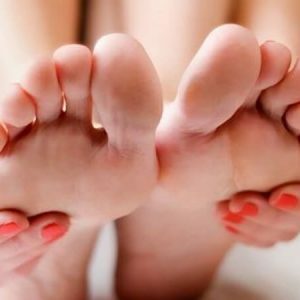 Important: one of the probable causes of hyperkeratosis is considered a hereditary factor - a genetically determined violation of the process of keratin biosynthesis.In some cases, hyperkeratosis is a direct consequence of fungal lesions of the feet.
Important: one of the probable causes of hyperkeratosis is considered a hereditary factor - a genetically determined violation of the process of keratin biosynthesis.In some cases, hyperkeratosis is a direct consequence of fungal lesions of the feet.
The probability of pathological keratinization of the skin increases significantly when two or more predisposing factors are combined.
With increased and( or) excessive pressure on the soles, epidermal growth cells begin to actively divide into the soles.Normally, the deadened elements of the outer layer slough, and their place is occupied by new ones.But under external influence, the multiplication of cells proceeds so intensely that the upper ones do not have time to fall off.As a consequence, the horny epithelium thickens many times.
Important: hyperkeratosis affects people with significant body weight due to constitutional features( high growth, dense body build) or metabolic disorders( overweight, obesity).Excessive pressure on individual parts of the soles is noted with congenital deformities of the foot( clubfoot or flat feet), as well as with acquired changes in the anatomical structures( after serious traumatic injuries of the lower limbs and surgical interventions).
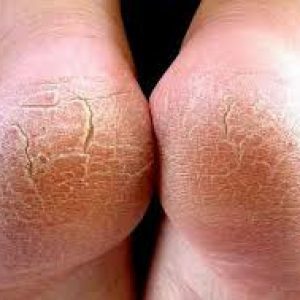 With such biomechanical disturbances, the load on the separate( support) areas of the foot can exceed the usual ones by several times.A thick, cornified layer of the outer edge of the sole is formed when the foot is turned inside when walking.Hyperkeratosis of the inner part of the sole is characteristic for the weakening of the muscles and ligaments of the ankle and the incorrect position of the heel.
With such biomechanical disturbances, the load on the separate( support) areas of the foot can exceed the usual ones by several times.A thick, cornified layer of the outer edge of the sole is formed when the foot is turned inside when walking.Hyperkeratosis of the inner part of the sole is characteristic for the weakening of the muscles and ligaments of the ankle and the incorrect position of the heel.
Unsuccessfully chosen footwear also threatens with the appearance of problems with the feet.Dangerous not only a close pair that exerts direct pressure, but vice versa - too spacious or diffuse, since the foot is not fixed in it and there is additional friction of .Initial signs of hyperkeratosis are often detected in women who prefer high-heeled shoes, because when they are worn, the pressure is not distributed evenly on the entire sole, but mainly on the heel and the base of the fingers.
Metabolic disorders lead to deterioration of the skin.Such a widespread and very dangerous disease like diabetes, is characterized by severe disorders of carbohydrate metabolism.Against their background, the nutrition of the tissues of the lower limbs is disrupted, resulting in not only dry skin and hyperkeratosis, but also trophic ulcers.
The pathological keratinization of the epidermal layer is quite typical for skin diseases such as ichthyosis, psoriasis and keratodermia of the plantar and palmar regions.
Hyperkeratosis may be an indirect evidence of problems with the liver or thyroid .The pathological thickening of the epidermis often develops in hypovitaminosis in vitamin A and ascorbic acid.
Among the complications of hyperkeratosis of the feet are:
- soft and hard( root) corns;
- point hemorrhages( hemorrhages);
- crack;
- ulcers( appear relatively rarely).
Corns and punctate hemorrhages do not pose a particular threat to health;Most often they are regarded as a cosmetic defect.
Cracks can cause significant discomfort;When walking is often painful.Their appearance is not always due to hyperkeratosis.The reason is often the wrong foot care.At cracks it is possible not only a bleeding, but also an infection that threatens with serious consequences.
Ulcers are more common in patients with diabetes mellitus.
All factors contributing to the development of plantar hyperkeratosis can be divided into two groups - external( exogenous) and internal( endogenous).
How to treat hyperkeratosis of the feet?
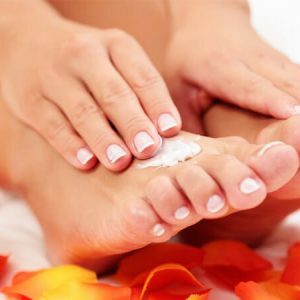 Salon and home treatments are used to reduce the thickness and soften the stratum corneum.
Salon and home treatments are used to reduce the thickness and soften the stratum corneum.
Specialists-podology recommend to independently process feet with preparations of rosemary, lavender and mountain pine. Quickly to achieve a positive effect allows comprehensive care.It involves local application of a special tonic in the morning, the main drug for the night, and therapeutic foot baths at least twice a week.
A well-known hygienic device - pumice - can be used to remove the hard horny layer at home.If you apply it daily, after steaming the feet, you can get rid of the overgrown layer of coarse epidermis in time.To prevent hyperkeratosis, only a few pumice movements are enough once a day.Do not forget to thoroughly wash the hygiene item after each use!
The standard scheme for the professional treatment of hyperkeratosis of the feet includes 3 stages:
- softening of the coarse stratum corneum;
- removal of dead epidermal cells;
- skin resurfacing.
 Softening is carried out with the help of conventional foot baths.Essential plant oils or sea salt can be added to the water.In addition, cosmetology has an extensive arsenal of modern softening solutions and special softening gels.The composition of many drugs in this category includes antibacterial and antifungal components.
Softening is carried out with the help of conventional foot baths.Essential plant oils or sea salt can be added to the water.In addition, cosmetology has an extensive arsenal of modern softening solutions and special softening gels.The composition of many drugs in this category includes antibacterial and antifungal components.
Coarser fragments are removed by means of a disposable cutting tool.In the interdigital spaces, the sites of hyperkeratosis are removed by special hollow blades.The procedure is carried out very carefully, keeping only the thinnest layer above the pink skin.With a qualified procedure, under constant visual control, soft tissue injuries are excluded.
Grinding is performed manually with the help of ordinary saw blades of various degree of graininess or a special device with disposable abrasive nozzles made of ceramics .The second option is more preferable, since the use of the grinding device provides greater efficiency.This method is much more hygienic;In addition, the procedure takes much less time.
For the prevention of pathology to people leading an active lifestyle, it is strongly recommended to pay special attention to the selection of the best suitable footwear, and use orthopedic insoles to evenly distribute the load to the sole.With all the recommendations from hyperkeratosis, you can get rid of once and for all.
Plisov Vladimir, medical reviewer

